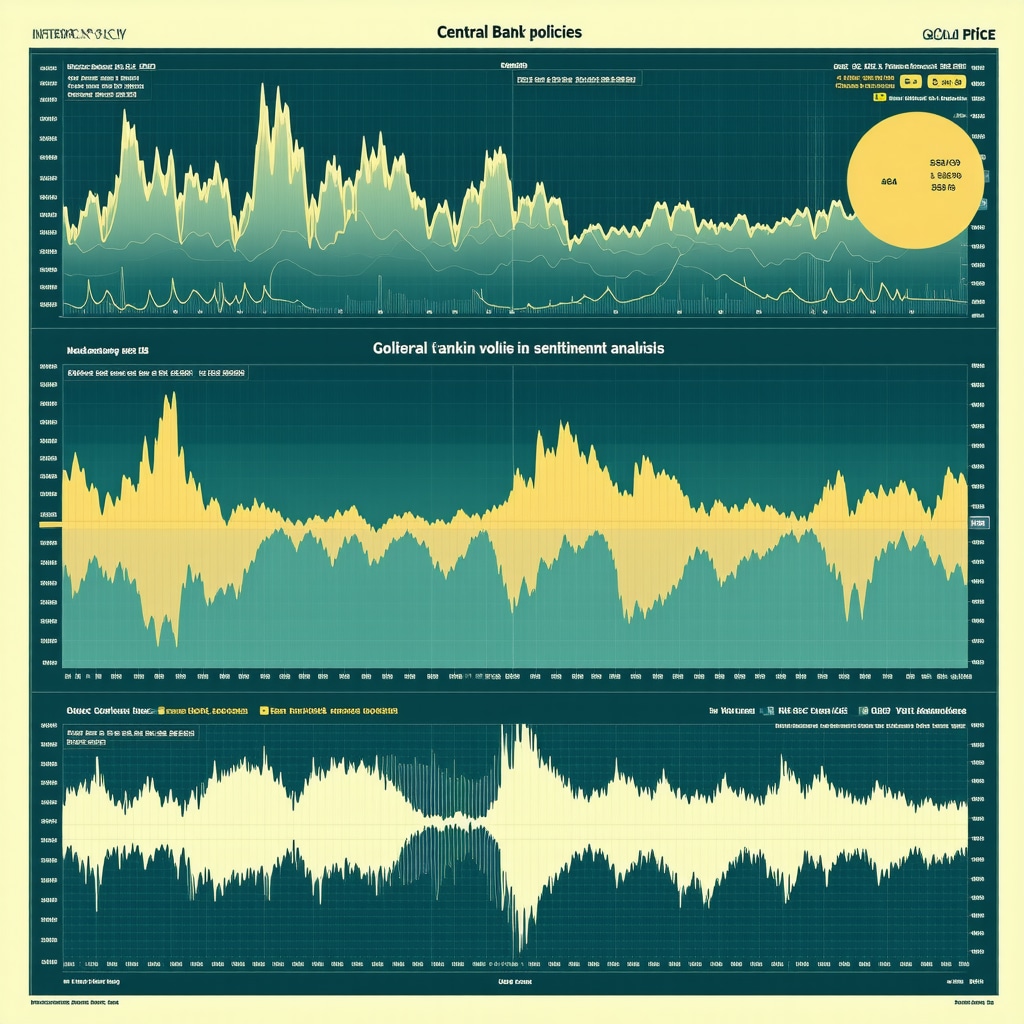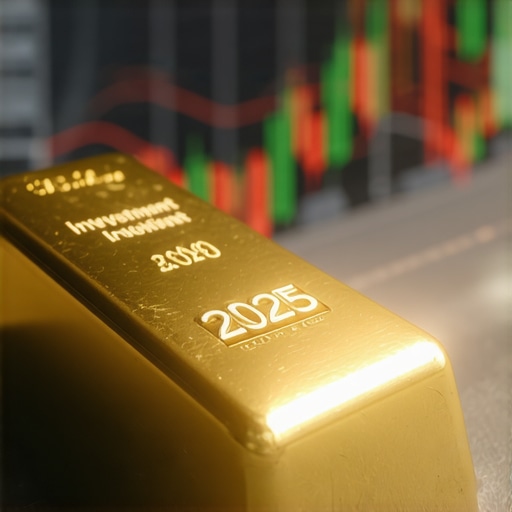When the Market Gets Moody, Gold Shines Bright
Picture this: the stock market plunges, headlines scream recession fears, and your portfolio’s value feels like a rollercoaster on a rainy day. Amid the chaos, there’s a timeless asset that investors often turn to for calm — gold. But why do so many savvy investors still swear by this glittering metal over volatile stocks? Let’s dive into the top reasons why gold investments can be a smart choice, especially when the financial seas get rough.
Gold’s Glittering Track Record of Stability
Unlike stocks, which can soar or plummet based on company performance, economic data, or even a tweet, gold has held its value for millennia. It’s the ultimate store of value. During economic downturns or inflationary periods, gold often acts as a safe haven, preserving wealth when currencies falter. This isn’t mere speculation — according to a detailed analysis by Investopedia, gold has historically outperformed stocks during periods of market stress.
Isn’t It Time to Give Your Portfolio a Golden Glow?
Could Gold Be the Hedge Your Stocks Are Missing?
Stocks and gold don’t dance to the same tune. When stocks suffer, gold often gains—offering that beautiful diversification investors crave. Adding gold investments, whether through physical bars, coins, or ETFs, can reduce overall portfolio risk. Curious about the different ways to invest in gold? Check out this comprehensive guide on types of gold investments to find what suits your style.
The Tangible Appeal of Physical Gold
Stocks are digital entries on a screen, but gold is something you can hold, store in a safe, and even pass down as a family heirloom. This tangibility adds a layer of trust and security for many investors wary of digital-only assets. If you’re considering physical gold, exploring how to choose between bars and coins can be a game changer for your investment strategy.
Gold’s allure isn’t just about shiny aesthetics—it’s about a tested, trusted way to hedge against inflation, geopolitical uncertainty, and economic turbulence. Stocks may offer growth, but gold offers peace of mind. So, what’s your take? Have you dipped your toes in gold investing yet? Share your experiences or questions below — let’s get the conversation sparkling!
Understanding Gold’s Role Amid Economic Uncertainty
As the global economy faces unpredictable shifts, investors increasingly look to gold not just as a safety net but as a dynamic component of portfolio strategy. Beyond its traditional reputation as a store of value, gold’s behavior in correlation with other asset classes provides nuanced insights into managing volatility and capital preservation. For those seeking to deepen their strategic grasp, analyzing gold’s interaction with macroeconomic indicators can reveal patterns that inform smarter investment choices.
Exploring Strategic Gold Investment Vehicles
While physical gold offers tangible security, the financial ecosystem around gold investments is rich and diverse. Gold ETFs and mutual funds provide liquidity and diversification, allowing investors to engage with gold markets without the complexities of storage or authentication. Meanwhile, gold mining stocks offer exposure to operational leverage, potentially amplifying gains but also introducing company-specific risks. Balancing these options can optimize portfolio resilience, as detailed in this expert guide on gold investment types.
How Do Market Sentiments and Central Bank Policies Shape Gold Prices?
Central banks worldwide play a pivotal role in the gold market, with their purchasing behaviors often signaling broader economic trends. When these institutions increase gold reserves, it can drive prices upward, reflecting confidence or hedging against currency devaluation. Conversely, shifts in interest rates and inflation expectations also affect gold’s appeal as an investment. Understanding these dynamics equips investors to anticipate price movements and adjust their holdings proactively.
According to the World Gold Council, central bank gold buying surged notably in recent years, underscoring its importance in global financial stability strategies (World Gold Council Central Bank Reserves Report).
Optimizing Physical Gold Investments: Safety and Authenticity
For investors opting for physical gold, ensuring authenticity and secure storage cannot be overstated. Counterfeit risks necessitate purchasing from trusted dealers and understanding hallmarking standards. Furthermore, deciding between gold bars and coins impacts liquidity and premium costs. Comprehensive advice on these considerations is available in our physical gold authenticity verification guide and comparison of bars versus coins.
What Emerging Trends Could Redefine Gold Investment Strategies in 2025 and Beyond?
Looking ahead, technological innovations such as blockchain-based gold tokens and evolving geopolitical landscapes could reshape how investors approach gold. How might these developments influence liquidity, transparency, and accessibility? Engaging with these questions prepares investors for a landscape where traditional and modern investment vehicles blend, offering new opportunities and challenges.
For readers eager to expand their knowledge, exploring effective gold trading techniques for 2025 can provide actionable insights to enhance portfolio performance.
Your perspective enriches the dialogue — share your strategies, questions, or experiences with gold investment in the comments below, or share this article with fellow investors to spark insightful conversations.
Decoding Gold’s Complex Relationship with Inflation and Interest Rates
While gold is often lauded as a hedge against inflation, the interaction between gold prices, inflation metrics, and interest rates is far from linear. Rising inflation typically increases gold’s appeal as a store of value; however, the influence of real interest rates—the nominal interest rate minus inflation—plays a crucial role. When real rates turn negative, gold becomes more attractive since it bears no yield, making the opportunity cost of holding gold lower compared to interest-bearing assets. Yet, during periods of rising real rates, gold may underperform as investors chase yield-bearing instruments. This nuanced dynamic requires investors to monitor macroeconomic indicators closely rather than relying solely on inflation trends.
How Can Investors Leverage Macroeconomic Indicators to Predict Gold Price Movements?
Expert investors analyze a blend of economic data, including CPI readings, real interest rates, and central bank policy statements, to anticipate shifts in gold prices. For instance, the Federal Reserve’s communications about tapering quantitative easing or hiking rates often trigger immediate reactions in gold markets. Moreover, geopolitical tensions and currency fluctuations, especially in the US dollar, intricately impact gold valuations. A multidisciplinary approach combining economic fundamentals and geopolitical risk assessments enables a more proactive and informed gold investment strategy.
Innovative Gold Investment Technologies: Blockchain and Tokenization
The advent of blockchain technology is revolutionizing traditional gold investing by introducing tokenized gold assets. These digital tokens represent ownership of physical gold stored in secure vaults, offering fractional investment opportunities and enhanced liquidity. Unlike traditional physical gold purchases, tokenized gold can be traded 24/7 on digital exchanges, reducing barriers to entry for smaller investors. Additionally, blockchain’s inherent transparency and immutability provide a robust audit trail, mitigating concerns about authenticity and provenance that plague conventional physical gold markets. However, investors should remain vigilant regarding regulatory frameworks and platform credibility when venturing into this emerging space.
Balancing Gold Mining Stocks and Physical Gold: A Dual-Asset Approach
Gold mining equities introduce a layer of operational leverage absent in physical gold, meaning that as gold prices rise, mining stocks often experience amplified gains. Conversely, during downturns, these stocks can be more volatile due to company-specific risks such as mining costs, geopolitical factors affecting mining jurisdictions, and management effectiveness. Incorporating both physical gold and mining stocks can create a nuanced portfolio balance—physical gold offering stability and mining stocks providing growth potential. Sophisticated investors often monitor mining companies’ production costs, reserve replacement ratios, and geopolitical risk exposure to optimize this balance.
Mitigating Risks in Gold Investment: Authentication, Storage, and Market Timing
Investors must prioritize authentication techniques to avoid counterfeit gold, including verifying hallmark certifications, using advanced assay technologies, and employing third-party grading services. Secure storage solutions, whether private vaults or insured depositories, are equally critical to protect against theft and loss. Additionally, market timing plays a subtle but important role; understanding cyclical patterns in gold demand—such as seasonal buying trends linked to cultural festivals or industrial demand spikes—can enhance entry and exit points. Comprehensive risk mitigation strategies integrate these elements into a cohesive investment framework.
For those eager to deepen their strategic expertise, the World Gold Council’s Gold Investment Fundamentals Report offers an authoritative resource detailing these complex interactions.
Ready to elevate your gold investment acumen? Explore our upcoming analysis on advanced portfolio integration techniques and the interplay between gold and emerging asset classes. Share your thoughts or queries below to join a community of discerning investors pushing the boundaries of precious metal strategies.
Deciphering Gold Price Volatility in an Era of Shifting Monetary Policies
In 2025, gold’s price dynamics remain intricately tethered to the evolving landscape of global monetary policies. Central banks’ maneuvers—whether tightening or loosening liquidity—directly reverberate through gold markets. For instance, when the Federal Reserve hints at rate hikes or signals quantitative tightening, traditional patterns suggest a dampening effect on gold prices due to increased opportunity costs. Yet, paradoxically, geopolitical uncertainties and inflation fears can counterbalance these effects, fueling gold’s demand as a safe haven. Navigating this complex matrix requires investors to parse not only headline economic announcements but also anticipate nuanced shifts in policy language and implementation timelines.
How Can Sophisticated Investors Integrate Sentiment Analysis with Fundamental Gold Market Drivers?
Beyond conventional economic indicators, sentiment analysis powered by AI and big data analytics offers a frontier for gold investors seeking an edge. By mining social media trends, news sentiment, and institutional investor positioning, investors can gauge market psychology that often precedes fundamental shifts. For example, sudden surges in geopolitical risk sentiment on platforms like Twitter or Bloomberg terminals can presage increased gold buying before official economic data reflect the change. Integrating these sentiment metrics with core fundamentals—such as inflation rates, USD strength, and central bank purchases—enables a multidimensional strategy that anticipates market moves rather than merely reacting.
For readers interested in harnessing these advanced techniques, this comprehensive guide on effective gold trading techniques for 2025 offers actionable strategies blending technical and sentiment analysis.
Tokenization of Gold: The Next Frontier in Democratizing Precious Metal Investment
The rise of blockchain-enabled gold tokens is revolutionizing accessibility and liquidity in gold investing. These tokens represent fractional ownership of physical gold stored securely in insured vaults, combining the trust of tangible assets with the ease of digital trading. For investors wary of the traditional hurdles of physical gold—such as storage, insurance, and authentication—tokenized gold provides a seamless alternative with 24/7 market access. However, regulatory clarity remains in flux, and due diligence on platform credibility is paramount to mitigate counterparty risks.
Investors eager to explore this cutting-edge domain should balance enthusiasm with caution, ensuring platforms adhere to stringent security protocols and transparent audit trails. This innovation not only broadens participation but also fosters price discovery and market efficiency in gold trading.
Strategic Synergy: Combining Physical Gold and Gold Mining Stocks for Optimized Growth and Stability
While physical gold offers a reliable store of value, gold mining stocks introduce growth leverage linked to operational efficiencies and exploration successes. The dual-asset approach capitalizes on gold’s intrinsic stability and the potential for amplified returns through mining equities. Yet, this strategy demands rigorous analysis of mining companies’ fundamentals—including production costs, geopolitical risk exposure, and reserve replacement rates—to mitigate volatility.
For a detailed primer, exploring gold mining stocks’ risks and rewards can equip investors to judiciously balance their portfolios with these complementary assets.
What Are the Most Effective Authentication and Storage Practices for Physical Gold in 2025?
Securing authenticity and safe storage remains paramount for physical gold investors. Modern authentication blends traditional hallmark verification with advanced assay technologies like X-ray fluorescence (XRF) and laser-induced breakdown spectroscopy (LIBS), ensuring gold purity and provenance. Trusted dealers with robust reputations, such as those listed in our best gold dealers guide, further reduce counterparty risks.
Storage options have evolved beyond private safes to include insured third-party vaults with sophisticated security measures, offering peace of mind and liquidity advantages. Investors should weigh costs, accessibility, and insurance coverage when selecting storage solutions. Combining rigorous authentication with secure storage fortifies the foundation of a resilient physical gold investment strategy.
To deepen your expertise, consider the World Gold Council’s Gold Investment Fundamentals Report, an authoritative resource dissecting these critical facets.
Gold investment in 2025 demands a blend of traditional wisdom and cutting-edge tools. How are you adapting your strategy to these evolving complexities? Share your insights or questions below — let’s elevate the conversation and capitalize on gold’s timeless allure together!

Expert Insights & Advanced Considerations
Integrating Macroeconomic Indicators with Sentiment Analysis for Proactive Gold Investment
Combining traditional economic data—such as CPI trends, real interest rates, and central bank policies—with AI-powered sentiment analysis offers a cutting-edge edge in predicting gold price movements. This multidisciplinary approach enables investors to anticipate market shifts early by gauging investor psychology alongside fundamental drivers.
Balancing Physical Gold and Mining Stocks for Optimal Portfolio Resilience
Employing a dual-asset strategy that blends the stability of physical gold with the growth potential of gold mining equities can enhance portfolio diversification. This requires rigorous evaluation of mining companies’ production costs, geopolitical risks, and reserve sustainability to mitigate volatility while capturing upside leverage.
Leveraging Blockchain Tokenization to Democratize Gold Ownership
Tokenized gold assets on blockchain platforms are transforming accessibility and liquidity by enabling fractional ownership and 24/7 trading. While this innovation lowers entry barriers, investors must remain vigilant about regulatory developments and platform credibility to safeguard their investments.
Prioritizing Authentication and Secure Storage to Mitigate Physical Gold Risks
Advanced authentication methods such as XRF and LIBS assays, alongside purchasing from reputable dealers, are essential to avoid counterfeit risks. Equally critical is choosing insured and highly secure storage solutions that balance cost, accessibility, and security to protect physical gold holdings effectively.
Curated Expert Resources
- World Gold Council’s Gold Investment Fundamentals Report: An authoritative resource providing in-depth analysis on gold’s role in portfolios, authentication techniques, and market dynamics.
- Effective Gold Trading Techniques to Maximize 2025 Profits: Offers actionable strategies blending technical and sentiment analysis tailored for the evolving gold market.
- Best Gold Dealers to Trust for Secure Physical Gold Purchases: A curated guide to reputable dealers ensuring authenticity and reliability in physical gold acquisition.
- Physical Gold Investments: How to Choose Between Bars and Coins: Detailed insights on liquidity, premiums, and strategic considerations for physical gold forms.
- Gold Mining Stocks Risks and Rewards for Smart Investors: Comprehensive analysis of mining equities to help balance growth and risk in gold investing.
Final Expert Perspective
Gold investing in 2025 is a sophisticated interplay of time-tested fundamentals and emerging technologies. By understanding the nuanced relationship between macroeconomic forces and market sentiment, leveraging innovative tokenization platforms, and maintaining rigorous standards for physical gold authentication and storage, investors can elevate their portfolio resilience and capitalize on gold’s enduring appeal. For those committed to mastering these complexities, engaging with expert resources and adopting a balanced, forward-looking investment approach will be essential.
Ready to deepen your expertise? Explore advanced strategies such as those detailed in effective gold trading techniques for 2025 and refine your approach to secure, profitable gold investments. Share your insights or questions below — let’s continue this expert conversation and unlock gold’s full potential together.









